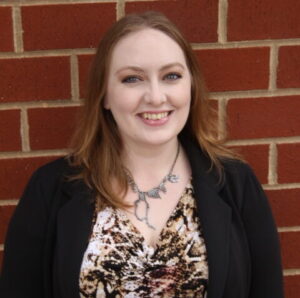⇒Research Interests
⇒Teaching Philosophy
⇒Contributions to Equity
Research Interests
Molecular paleontology is an emerging subdiscipline within paleontology, with only a few decades of research amassed to date. Yet, in such a short time, it has changed how we approach questions of evolutionary relationships within extinct taxa, and called into question some of our long-held assumptions about both the geochemical processes that drive fossilization and the molecules that compose living tissues. Because this field is still developing, our efforts to answer many crucial questions about ancient protein preservation and how to characterize it have done little more than scratch the surface. Thus, molecular paleontology is rife with opportunities for ground-breaking, transformative discoveries.
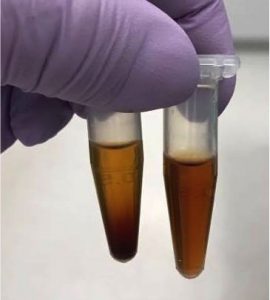
Extract from fossil tissue
My research centers on paleoproteomics—the application of mass spectrometry (specifically tandem mass spectrometry, or LC-MS/MS) to archeological and paleontological specimens from a variety of ages and taxa, to probe their preserved protein content by characterizing protein sequences. This approach is complementary to, but distinct from, other molecular methods that are often employed to examine fossils, such as immunological and spectroscopic techniques. While these techniques can detect the presence of protein in a sample, they are not capable of identifying the sequences of the proteins they detect. Such sequences can be used to explore, on a genetic basis, the phylogeny and paleobiology of extinct species from which DNA is no longer accessible—and LC/MS-MS is the only paleomolecular method that can characterize and validate the amino acid sequence that comprise preserved protein.
My current research is focused on elucidating the unique challenges of applying this powerful tool to fossil specimens and developing methodology to overcome them, thereby enabling the application of high-resolution LC-MS/MS to increasingly older and more recalcitrant tissues. Because my research focuses on a methodological approach to paleontology, rather than a specific taxonomic group or time period, it can encompass fossils from a wide range of ages, tissue types, lineages, and depositional environments, opening up greater and more diverse opportunities for graduate student projects, undergraduate research projects, and collaborations with biologists, paleontologists, and forensic pathologists.
My immediate projects focus on developing novel methods to extract specific target proteins from extant and fossilized tissues, and to eliminate interfering diagenetic products that interfere with MS instrumentation. These include:
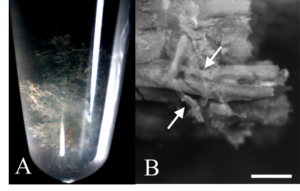
(A) Blood vessels isolated from emu bone. (B) Vessels demineralized from fossils of Dreadnoughtus (Schroeter et al., 2022).
Development of methodology for proteomic analyses of blood vessel elastin
Elastin is a protein that is abundant in vasculature. Because it is very hydrophobic and highly crosslinked in tissues, it is hypothesized to have a very high preservation potential. However, the qualities that benefit the preservation of elastin also impede its characterization, as it is extremely difficult to solubilize from tissues using standard protocols. As a result, the protein sequence of elastin is poorly known, even for living and well-analyzed species. Currently, I am developing novel methodology to extract elastin directly from vertebrate blood vessels using specialized enzymes and protocols that circumvent issues of insolubility. Once optimized, this protocol can be utilized for vasculature studies of any extant species, as well as the analyses of the fragmentary blood vessels recovered from various Mesozoic and Cenozoic taxa. Initial stages of this project have been presented at the American Society for Mass Spectrometry, and have also been conducted by an undergraduate researcher, leading to a presentation at the State of North Carolina Undergraduate Research & Creativity Symposium.
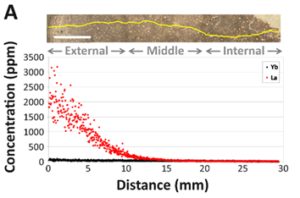
Differential updake of REEs lanthanum (Ln) and ytterbium (Yb) across the humeral cortex of the Dreadnoughtus holotype (Schroeter et al., 2022).
Correlation of protein preservation with taphonomic history
One of the reasons molecular paleontology remains a controversial field is that we still have only a rudimentary understanding of how biomolecular preservation happens at the chemical level. To move the field forward, we must reinvigorate efforts to characterize the geochemical pathways responsible for these phenomena. Currently, I am collaborating with geochemist Paul Ullmann at Rowan University to conduct joint analyses of fossils specimens over a wide range of ages (i.e., Pleistocene to Mesozoic) that quantifies both their proteomic content and their rare earth element (REE) uptake profile. This project will provide data that allows the direct comparison of a fossil’s molecular preservation with its taphonomic history at an unprecedented level of detail. By constraining aspects of the burial environment leading to preservation, this project will both lay the foundation to build and test hypotheses around geochemical preservation mechanisms, and provide a screening tool for selecting the most ideal specimens to analyze using a molecular approach. Preliminary results of this project have been published for two Mesozoic taxa, Brachylophosaurus (Ullmann et al., 2020) and Dreadnoughtus (Schroeter et al., 2022). A collaborative grant to support this project is currently under review at NSF (February 2023).
Adaption of parallel reaction monitoring (PRM) for analyses of fossils
Paleoproteomic investigations to the taxonomic identity of fragmentary Cenozoic fossils typically utilize a method called “peptide mass fingerprinting” (PMF). PMF is a limited technique, because it relies on the preservation of large portion of the collagen I sequence, and does not provide protein sequence data, or any other biologically relevant molecular information beyond low-resolution taxonomic identification. Recent advances in tandem MS like multiple reaction monitoring (MRM) and parallel reaction monitoring (PRM) now allow us to both detect target peptides of interest and confirm their identification with high-resolution sequence data, instead of a broad digest “fingerprint.” This approach is far superior to the more widely used PMF in both specificity and sensitivity, and holds potential for taxon identifications using more degraded and/or older tissues, non-collagenous tissues, and non-collagenous bone proteins. However, PRM is still in the early stages of being applied to extant bone tissue, and must be optimized for paleoproteomics. Establishing PRM for paleoproteomics will be a multi-phase project, in which each stage will provide a wealth of sub-projects producing multiple publications in their own right: 1) methods development for the optimized extraction of protein for PRM from extant bone, fossilized bone, and other fossil tissues (e.g., skin, horn, tooth enamel); 2) identification of sequence regions in the bone proteins of extant taxa that can be used as species identifiers; 3) troubleshooting diagenetic interference by applying PRM methods to archeological fossils of known taxonomic affinity; 4) application of the optimized method to indeterminate fossils. These objectives will provide opportunitiesfor multiple graduate student projects, as well as collaborations with faculty working with extant or recently extinct taxa.
Teaching Philosophy
When I left full-time employment as a developer of youth science programs to pursue my doctorate, my objective was to seek a tenure-track position where I could simultaneously satiate my life-long curiosity about ancient life while directly impacting curious young minds just beginning their academic journey. My primary goal as a teacher is to instill in students a foundation of critical thinking that will turn them into problem solvers, both in their scientific endeavors, and in other aspects of their life.
Philosophy, Pedagogy, and Curricula Design
I believe that science should be taught as an active pursuit rather than an abstract concept. In my courses, this is realized by incorporating inquiry-based learning, group discussions, and hands-on activities into classes of all sizes, so that students are actively engaging in the material. This has taken many forms, including group discussions about taphonomy over a partial bison carcass, and analyses of Halloween decorations for their osteological accuracy. To stay current with emerging pedagogical techniques, I completed a Teaching & Communication Certificate at NC State that encompassed 100 hours of professional development in best-practices for teaching and science communication in May 2019.

BIO 230 students staying after class to ask questions about a cast of an Allosaurus skull.
However, it is not enough that class material is engaging and thought-provoking; it must also be accessible for everyone. First generation college students, continuing education college students, and students from underserved and underrepresented backgrounds may face barriers to their full participation in class not experienced by their peers. For example, they may have child or family care responsibilities, or may need to juggle part time or full-time jobs to be able to afford their tuition. Additionally, students that experience anxiety, are immunocompromised (or otherwise vulnerable to COVID-19), or are dealing with other mental and physical health considerations may experience hardships attending class or exams synchronously and/or in-person. Fostering equity in the classroom requires that we provide avenues for all students to participate fully, and not assume that all students are equally unencumbered. With this in mind, I design my courses with the following elements (as appropriate):
- Course Inclusivity Statement: An explicit statement in the syllabus, on the first day of class, and at points throughout the semester that students are encouraged to reach out to me to discuss any obstacles they are experiencing to their participation in-class and their completion of assignments. Specific examples are given in class (i.e., childcare, part-time job), to illustrate that I welcome discussion of issues that some students may think “don’t count”—which in my experience has been any obstacle other than an illness for which they can provide a doctor’s note. This statement also explicitly welcomes students to discuss with me any aspect of the course, curricula, or classroom environment that could be improved to create a more inclusive atmosphere for their participation.
- Curricula Delivery through Moodle: All coursework is administered through Moodle, allowing deadlines or timing to be easily adjusted for students that are registered with the DRO, have excused absences, or have workload conflicts with other courses. Moodle course pages are set up to allow students to track their running grade total through the semester, enabling them to more effectively track their own progress and better identify when they are struggling so they can reach out for support.
- “Hybrid,” Synchronous Class Delivery: Students can opt to participate in-person or virtually throughout the semester. Virtual students engage in real time with class through chat/microphones. This allows persons that are temporarily or chronically sick, experiencing an event that make traveling to class difficult, or are otherwise unable to physically attend to more fully participate in class, while still providing in-person, hands-on experiences for students that prefer it.
- Recorded Lectures for Review: Lectures are recorded as they are given synchronously to the entire class, then posted on Moodle for students to review at any time. This enables students to re-review parts of lectures as they study, and allows students that experienced an unavoidable absence to catch up on the material in their own time, in a more effective way than borrowing notes. It also allows students to review the materials in the context in which they were delivered, and not as a PDF of lecture slides that only include part of the information conveyed during the lecture. Students are incentivized to attend class synchronously when able via a portion of their grade being earned through attendance/engagement, which can be recouped by students that have discussed their absences with me.
- Flexible Exam Window: On the day of an exam, students are allowed to choose a 90-minute window to complete their test, which is open-book and administered online. For courses in which I implement this policy, exams are drawn from a large question bank, from which each individual test is randomly drawn and shuffled. Since no two students have the same test or same order of questions, given the time constraints, it is not possible to do well on these exams by asking a classmate for the answers, or by soliciting the internet. Because the need for proctoring the exam in-person is eliminated, students are freed to take the exam at the time of day, location, and in an environment that is most comfortable for them. Additionally, students registered with the DRO can receive extended time on exams without needing to take it in a DELTA testing facility. For students that feel more comfortable taking a test when they have immediate access to an instructor, I hold an optional virtual meeting at regular class time the day of the exam, which students may use to ask clarification questions while taking the test if desired.
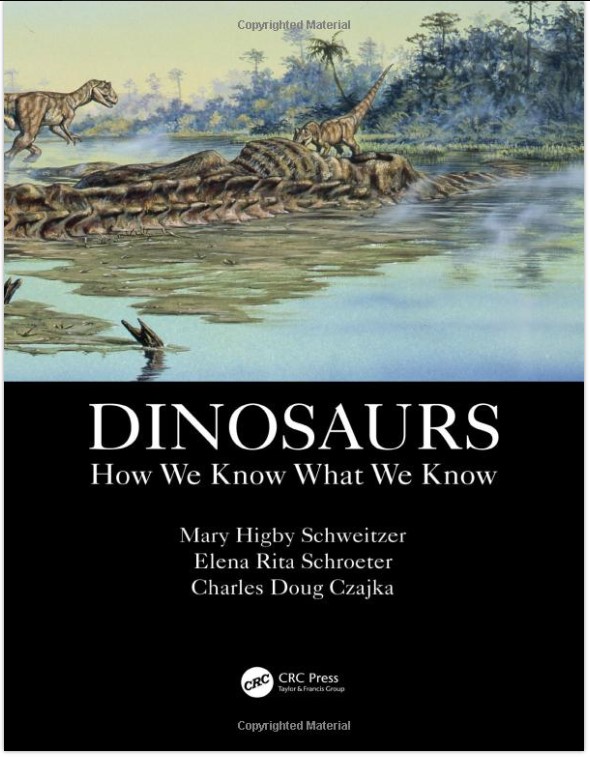
Schweitzer, M.H., Schroeter, E.R., Czajka, D. (2020). How do we know what we know about Dinosaurs? [ISBN 978036756381]
Science of Studying Dinosaurs (BIO 230): The aim of this class is not to simply unload the current state of our knowledge about dinosaurs onto students, but to walk them through the question “How can we know anything about things we cannot directly observe?” using dinosaurs as a case study. Students are introduced to the scientific method, deep time, geology, taphonomy, evolution, and other foundational topics that are usually assumed knowledge in similar courses. Because it is designed to be accessible for non-concentrators, enrollment is not limited to students already interested in paleontology; BIO 230 is often chosen as a science elective for non-biology majors, and provides an excellent opportunity for any student to build their civic scientific literacy with an engaging topic. In response to the pandemic, I redesigned this course so that it can be offered entirely virtually, entirely in-person, or a combination of both, opening up the possibility for increased class enrollment or remote offerings at partner institutions.
Because no introductory level text encompassed the breadth of material covered in this class, I co- authored the textbook “Dinosaurs: How We Know What We Know” to support this course. Like the class, this book discusses dinosaurs through the lens of discussing how we came to our current hypotheses, and what we still don’t know. Because it includes detailed chapters on foundational concepts, this book provides a resource for instructors to design accessible paleontology courses for non-concentrators.
Introduction to Evolution (BIO 270): In concert with other faculty in the NC State Dept. of Biosciences, I developed a team-taught course that asks undergraduates to consider evolution from different lenses within biological research as well as understand the history of its development as a scientific theory. My section of class introduces students to how we recognize evolution in the fossil record, and explores the topics of how we understand and measure deep time, how we account for loss of biological information in fossilized remains, and how we recognize evidence of life in rocks billions of years old.
Future Courses
Techniques in Molecular Paleontology (Proposed Undergraduate Class): . I will utilize my expertise and practical experience in a multitude of chemical, molecular, spectroscopic techniques to design an undergraduate course that introduces students to the concept of molecular paleontology, and provides them with a basic understanding of how each technique works, the type data it produces, and the limitations of what we can conclude or infer from each type of result. This course will be an excellent option for students that are pursuing the Paleontology Minor program, giving them the background to evaluate paleomolecular studies, even if they are not planning on pursuing that subdiscipline themselves. Additionally, it will serve as a primer for undergraduates that would like to gain direct experience in molecular paleontology techniques by completing a research credit in my lab.
Contributions to Equity & Inclusivity
The creation of academic spaces that foster equity and inclusion is a matter deeply personal to me, as systemic barriers to higher education have had (and continues to have) a direct impact on my own life and career. As a first-generation college student from the public school system of the South Side of Chicago, I represent a population of underserved students referred to as “first-generation low-income” (FGLI) (Schademan et al., 2016; J. Coll. Student Retent. Res. Theory Pract. 18, 194–216). As such, I am intimately, and sometimes painfully aware of the unique obstacles FGLI students face in their pursuit of advanced degrees.

PE Advanced Paleontologist Program, 2001
On the path towards my doctorate, I was supported by a science outreach organization called Project Exploration (PE), which provided docent, after-school, and immersive field programs to Chicago Public School students. I cannot express how crucial these programs were to my trajectory into science. They provided me with mentorship and opportunities to build my science and communication skills completely unavailable to me otherwise. These experiences had such an impact on my life that, for two years prior to graduate school, I worked for PE full time, where I helped design, improve, and deliver the outreach programs that had been my steppingstone. Working on the other side of outreach programming gave me a broader sense of the importance of equity in STEM learning, as I became a mentor for students from incredibly diverse backgrounds, most of them students of color. In this task I observed, and sought to help address, the myriad ways that different intersections of identity (e.g., race, gender, religion) require different mentorship needs, and are subject to different systemic obstacles in typical educational systems.
As faculty, I have utilized my personal experience—both in navigating higher academia as an underserved student, and in mentoring students from a wide range of intersectional, underrepresented backgrounds—to establish policies that promote inclusivity in my courses, as well as to advocate for systemic change within the field of Paleontology at large.
Discourse within the Field of Paleontology
The Geosciences are the least diverse branch STEM, and have shown no appreciable growth in diversity over the last 40 years (Bernard et al., 2018; Nat. Geosci. 11, 292–295). Though dinosaurs fascinate the public broadly, captivating children from all walks of life, the field of Paleontology is no more diverse than Geosciences as a whole. As a FGLI student that directly mentored other FGLI students in STEM outreach initiatives, who went on to be part of the field of Paleontology myself, I can say with certainty that there is a profound disconnect between the source of this disparity and how the field typically attempts to address it. Whereas paleontology outreach initiatives often focus solely on generating interest in underrepresented populations, interest alone cannot sustain a student through the rigors of higher academia when they lack access to the basic resources necessary to support their studies. Together with two women of color in paleontology, I co-authored a paper (Carter et al., 2022; Front. Ecol. Evol. 10, 1– 7) that discusses the many barriers to a career in geosciences that exist at each successive stage of academia, and how together these perpetuate a systemic lack of diversity in paleontology. We assert that unless these barriers are first addressed, “interest” will languish. We also provided insights from our personal experiences as underserved/underrepresented students navigating academia, and as researchers and educators ourselves. On this basis, we offer recommendations for how faculty can create more inclusive curricula for geoscience students in the classroom, in field courses, and in graduate programs.
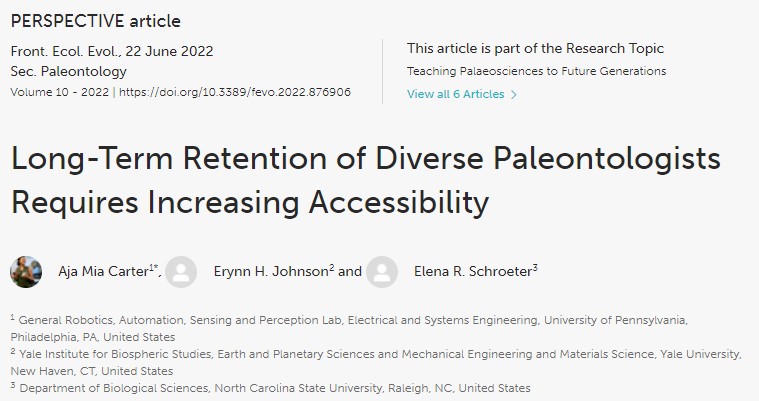
Fostering Equity and Inclusivity in the Classroom
Studies have shown that first generation college students are less likely to reach out to their professors for help when they are struggling, for fear of how they will be perceived (Hutchison, 2017; Coll. Q. 20, 1– 24). To overcome this misconception, I include explicit statements in my syllabi that encourage students to discuss any issues they are experiencing that affect their participation and sense of belonging in class— a point that I reiterate on the first day of class and periodically throughout the semester. Since adding this explicit language, students have reached out to me develop plans for turning in assignments around such varied personal situations as needing to provide unexpected care to an elderly relative after a sudden stroke, witnessing a stranger die in a car accident, and having a particularly rough day working as a paramedic on the night shift. In all these cases and many others, students have expressed to me that although a short extension of one or two minor assignments was all they needed to get back on track, they would not have asked for one had I not made it abundantly clear I would listen. Generally, they assumed that unless the issue they were facing was a typical “excused absence” (i.e., an illness or death for which they can provide documented proof), they should not even bother trying.
Given this feedback, I have been proactive in ensuring students know what resources are available to them, and in communicating my policies regarding events that may impact them. This past semester, my 8:30 am course fell on election day—which is awkward timing for any student who votes in an off- campus community. Before election day, I informed all students through email that missing class to vote would be an excused absence. Twelve students used that time to vote, many of whom expressed having been very anxious about fitting voting into their class schedule, or said they’d decided not to vote to avoid missing class until receiving my message. Waiting for students to contact me first would have left them with the assumption they had to choose between class and civic engagement; predicting and addressing this barrier to equity in advance was crucial for dispelling their misconception before it did tangible harm.
For students from populations underrepresented in science, seeing researchers that resemble them making discoveries is a critical component to envisioning their own career in science. To that end, I have made efforts to provide students in my courses with guest lectures by scientists of color. This past semester, I arranged for my co-author Dr. Aja Carter to lecture on how we study evolutionary transitions in the fossil record for both BIO 230 (The Science of Studying Dinosaurs) and BIO 270 (Introduction to Evolution). Dr. Carter’s visit allowed students to consider paleontology from a different lens—both through learning about her pathway into science as a black woman, and through her work as a paleoroboticist who explores the evolutionary transition of tetrapods onto land as a way to inform the construction of more agile robots. Going forward, I plan to increasingly utilize the remote learning technology (i.e., Zoom) to invite guest lectures from diverse backgrounds to share their science, and their journeys into science, with students. Additionally, remote guest lectures reduce the burden imposed on the invitee (in terms of time and travel), thereby making such experiences more accessible for the researchers as well.
Youth Outreach
From before graduate school, through my postdoctoral fellowship, and as an assistant research professor, I have a continuous record of providing school students with informal education opportunities in science. Most recently, this has frequently included presentations at grade schools throughout Wake County, NC. Although students get to learn about how we study dinosaurs, or how fossils form, the most important part of these presentations is that they provide students with access to a scientist, with whom they can share their curiosity and ask their burning questions. These interactions are especially crucial for rural schools in North Carolina, which may have limited access to museum visits or other resources. Currently, I have established relationships with the 4-H Crosby Discovery Camp (Raleigh, NC) and Lincoln Heights Elementary School (Fuquay-Varina, NC), where I give presentation to students ranging from 1st to 5th grade each summer (4-H) or semester (Lincoln Heights). I look forward to helping my future graduate students develop their own outreach curricula and begin establishing relationships with local educators.
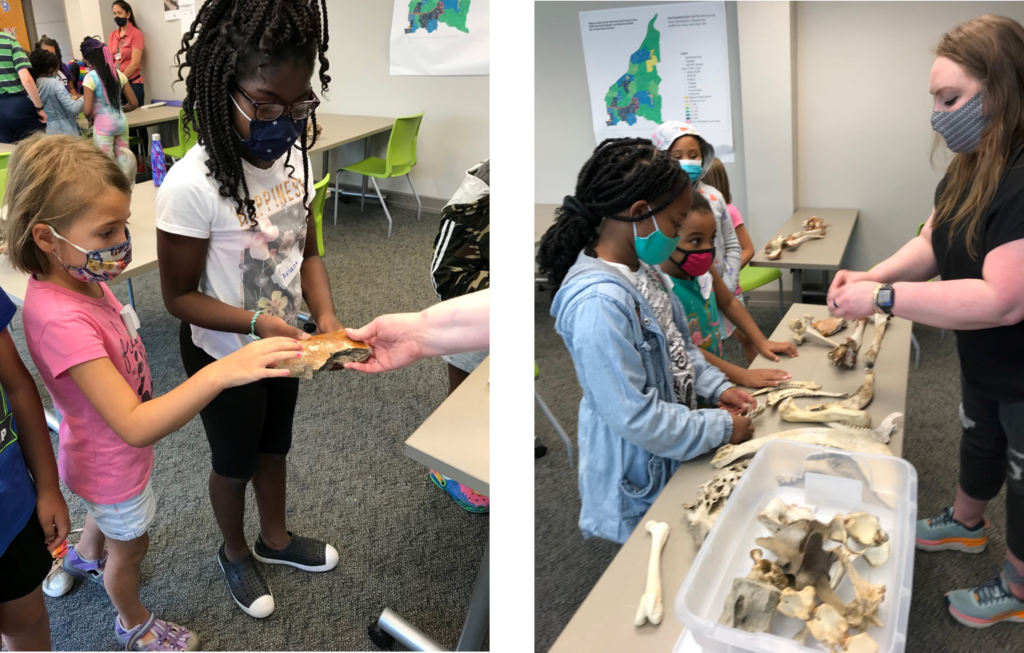
4H Crosby DIsovery Camp, July 25, 2022
